From the sprawling prairies of the east to the Badlands in the west, North Dakota’s diverse geography is a haven for various bird species. The state’s combination of wetlands, grasslands, and wooded areas offers a rich mosaic of habitats, attracting both migratory and resident birds.
Among its feathered inhabitants, a splash of orange often catches the observer’s eye, painting a vivid contrast against the state’s natural canvas. Dive into our guide to discover the 9 mesmerizing orange birds of North Dakota, and make sure to grab our complimentary photo guide to enhance your bird-watching experience!
Orange Birds Found In North Dakota
North Dakota features vast plains, rolling hills, and the meandering Missouri River cutting through its landscape. Seasonal changes further diversify the avian population, as many birds seek out North Dakota’s landscapes for breeding, wintering, or as a pit stop during their long migratory journeys. This intricate blend of terrains and the state’s location along central migration routes make it a treasure trove for bird enthusiasts seeking diversity in their sightings.
Baltimore Oriole


| Feature | Measurement |
|---|---|
| Scientific Name | Icterus galbula |
| Length | 6.7–8.7 in |
| Wingspan | 9.1–12.6 in |
| Weight | 22.3-42 g |
The Baltimore Oriole is a stunning bird, best known for its vibrant coloration and its rich, whistling song.
Appearance: The male Baltimore Oriole is notable for his bright orange and black plumage and black and white wing bars, a stark contrast to the more muted yellow-brown coloration of the female. Both sexes, however, have long pointed bills and white bars on their wings.
Diet: Baltimore Orioles have a diverse diet that includes insects, fruits, and nectar. Their preference for sweet juices and fruit pulp often brings them to backyard feeders offering oranges and jelly.
Reproduction: The female Baltimore Oriole is responsible for building the distinctive hanging nest, often woven together from fine materials like hair and grass. These nests are usually high in trees to avoid predators. The female lays 3-7 eggs, which are incubated for about two weeks.
Bullock’s Oriole

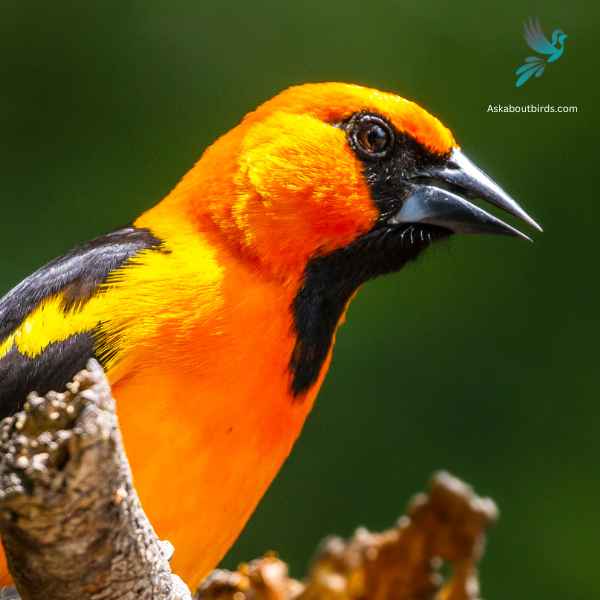
| Feature | Measurement (Imperial) |
|---|---|
| Scientific Name | Icterus bullockii |
| Length | 7.5-8.5 inches |
| Wingspan | 11.8-12.6 inches |
| Weight | 0.9-1.2 oz |
The Bullock’s Oriole is a bright and lively songbird, known for its stunning contrasting colors and vibrant melodies, predominantly found across the western regions of North America.
Appearance: The male Bullock’s Oriole boasts a brilliant orange chest, belly, and face with a black crown, eye line, throat, and back. Its wings are black with a prominent white patch and white-edged coverts. Females are more muted in coloration, displaying a yellowish-orange hue with grayish-brown wings that still retain the white patches.
Diet: These orioles primarily feed on insects, especially caterpillars, beetles, and grasshoppers. Apart from insects, their diet also includes fruits, berries, and nectar. They’re adept foragers, often hanging upside-down on branches to find hidden prey.
Reproduction: Bullock’s Orioles are noted for their skill in crafting hanging, woven nests, often positioned on the tips of slender branches, ensuring they are difficult for predators to access. Both parents partake in feeding the young, who then fledge about two weeks after hatching.
Spotted Towhee

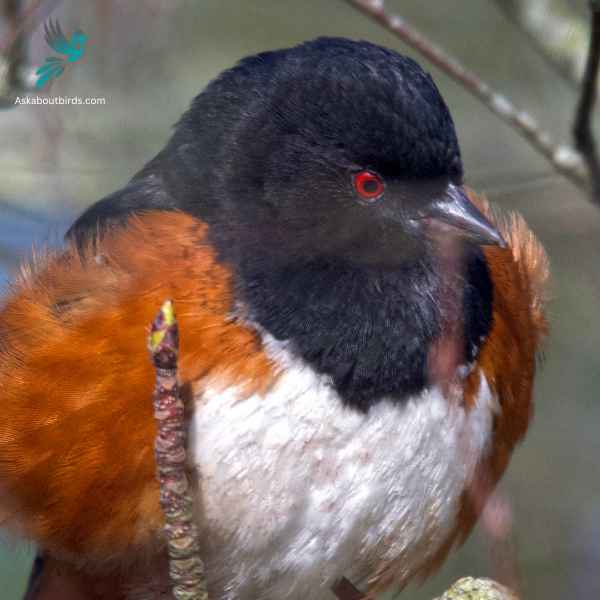
| Feature | Measurement |
|---|---|
| Scientific Name | Pipilo maculatus |
| Length | 6.7-8.3 in |
| Wingspan | 11.0 in |
| Weight | 33 g |
The Spotted Towhee is a distinctive songbird commonly found in the shrubby undergrowth and thickets of the western parts of North America. Its song, a series of melodious chirps, often punctuates the early morning air.
Appearance: Male Spotted Towhees showcase a coal-black head, throat, and upper body contrasted with rufous sides and a white belly. Their wings and back are dark but adorned with white spots, hence their name. Females have a similar pattern but are more brownish than black.
Diet: Spotted Towhees primarily feed on a mixture of insects and seeds. They often forage on the ground, scratching through leaf litter to uncover beetles, ants, and other insects, as well as various seeds and berries.
Reproduction: Spotted Towhees usually nest on the ground, concealed by dense vegetation or sometimes in low shrubs. The female builds the nest and lays a clutch of 3 to 5 eggs. She incubates the eggs, while the male stands guard and both parents partake in feeding the fledglings after hatching.
Red-breasted Nuthatch

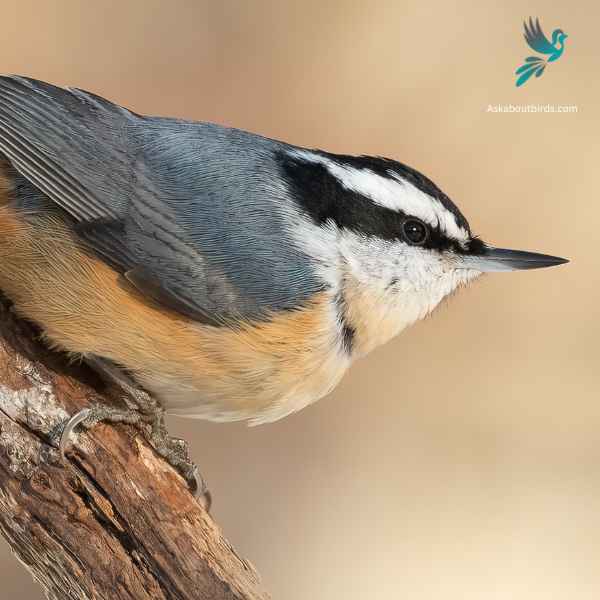
| Feature | Measurement |
|---|---|
| Scientific Name | Sitta canadensis |
| Length | 4.3–4.7 in |
| Wingspan | 8.3 in |
| Weight | 0.3–0.5 oz |
The Red-breasted Nuthatch is a small, agile songbird, known for its ability to move headfirst down tree trunks while searching for food.
Appearance: This bird boasts a slate-blue back and a pale rust-red underside. A prominent black stripe runs through the eye and is bordered above by a white eyebrow. Their sharp, pointed bill is characteristic of the species.
Diet: Red-breasted Nuthatches primarily feed on insects and seeds, especially those from coniferous trees. They have a fondness for large seeds, which they wedge into bark crevices to hack open with their bills.
Reproduction: These birds construct nests in natural tree cavities or abandoned woodpecker holes, often lining the entrance with resin. This is thought to deter predators or competitors from entering. The female typically lays a clutch of 5 to 6 eggs, and both parents partake in feeding the chicks once they hatch.
Orchard Oriole
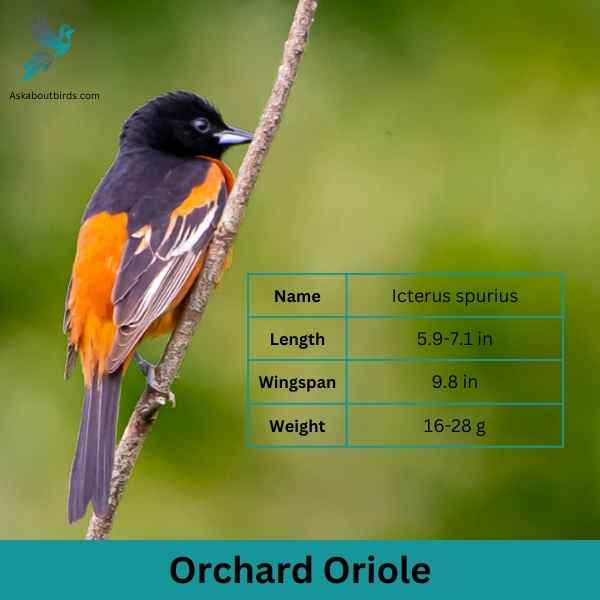
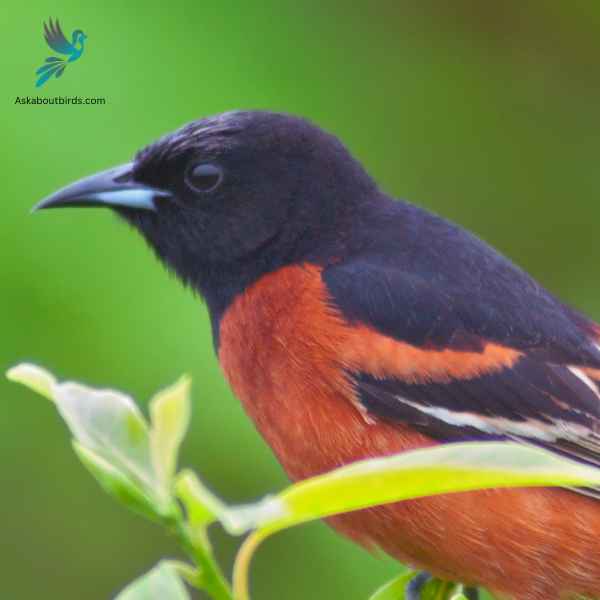
| Feature | Measurement |
|---|---|
| Scientific Name | Icterus spurius |
| Length | 5.9-7.1 in |
| Wingspan | 9.8 in |
| Weight | 16-28 g |
The Orchard Oriole is a small songbird noted for its distinctive coloration and melodic song.
Appearance: Male Orchard Orioles are a striking sight with their dark chestnut body and black head and black and white wings, while females and immature males are olive-green and feature a yellowish underpart. The species is often recognized by its slender body and pointed bill.
Diet: The diet of the Orchard Oriole consists primarily of insects, fruits, and nectar. They are adept at catching insects mid-air and are also known to sip nectar from flowers, aiding in pollination. When fruits are in season, they make up a substantial portion of the bird’s diet.
Reproduction: Orchard Orioles often nest in open woodlands and orchards, hence their name. The female is responsible for building the nest, typically choosing a location in a tree or shrub. The female lays a clutch of 4 to 6 eggs, which she incubates for about two weeks.
Northern Flicker

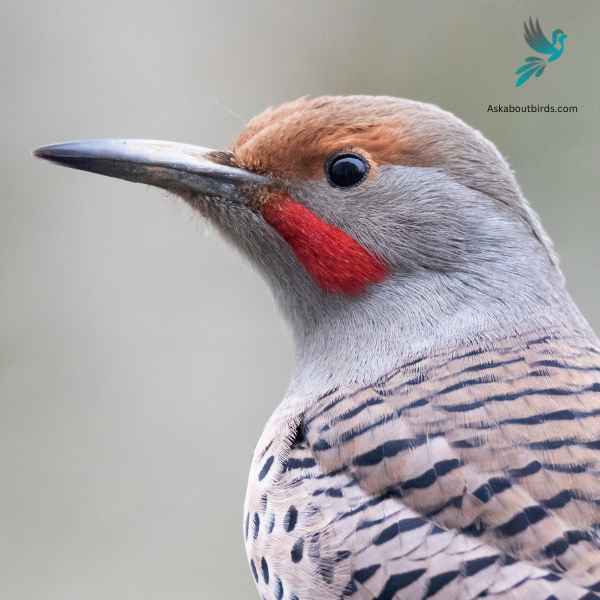
| Feature | Measurement |
|---|---|
| Scientific Name | Colaptes auratus |
| Length | 11–12 in |
| Wingspan | 17–20 in |
| Weight | 3.9–5.6 oz |
The Northern Flicker is a medium-sized woodpecker, recognized by its unique patterns and coloring, often found drumming on trees or foraging on the ground across North America.
Appearance: The Northern Flicker stands out with its grayish brown body, black-scalloped plumage, and a black bib. Males sport a distinctive black or red mustache stripe. Depending on the subspecies, the underwing and undertail feathers can be bright yellow or red, flashing vividly during flight.
Diet: While most woodpeckers are tree-bark foragers, the Northern Flicker prefers hunting on the ground. Its primary diet consists of ants and beetles, supplemented occasionally by fruits, berries, seeds, and other small insects.
Reproduction: Northern Flickers are cavity nesters, preferring to excavate their nesting hole in dead or diseased tree trunks. The interior of the nest is lined with wood chips.
Western Tanager

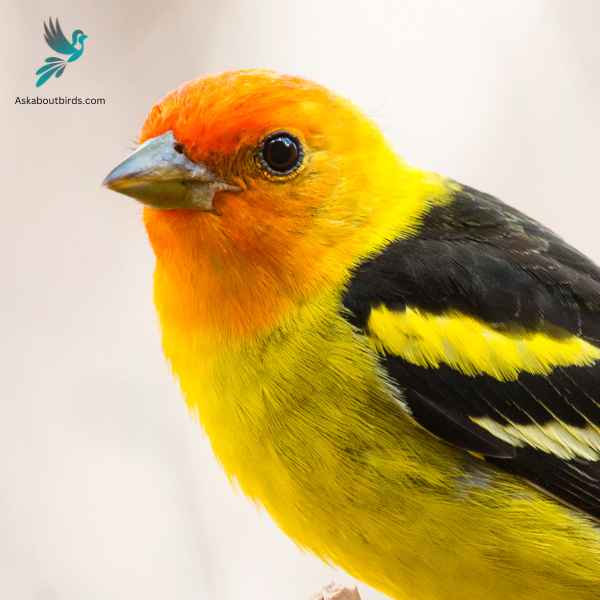
| Feature | Measurement |
|---|---|
| Scientific Name | Piranga ludoviciana |
| Length | 6.3-7.5 in |
| Wingspan | 11.5 in |
| Weight | 24-36 g |
The Western Tanager is a vibrant songbird that graces the forests and woodlands of the western regions of North America, enchanting observers with its colorful plumage and melodious song.
Appearance: The male Western Tanager is renowned for its bright yellow body contrasted with a striking red head and black wings and tail. The females are more subdued in hue, primarily being yellow with grayish wings and back, and lacking the brilliant red head of the males.
Diet: Western Tanagers primarily feed on insects, especially when breeding, but they also incorporate a significant amount of fruits and berries into their diet, especially during migration and winter.
Reproduction: Western Tanagers build their nests high in coniferous trees, often well concealed from potential predators. The female usually lays a clutch of 3 to 5 eggs and takes the primary role in incubation, while both parents are involved in feeding the chicks after they hatch.
House Finch


| Feature | Measurement |
|---|---|
| Scientific Name | Haemorhous mexicanus |
| Length | 5–6 in |
| Wingspan | 8–10 in |
| Weight | 0.6–0.9 oz |
The House Finch is a small songbird widely distributed across North America and is commonly found in urban and suburban areas.
Appearance: Males of this species are brightly colored with crimson faces and throats, which can extend to the chest and back, while their flanks have streaks. The female is streaked brown and lacks the red coloring. Both have a square-tipped tail and a distinctively long, flat-topped bill.
Diet: House Finches primarily eat seeds, grains, and berries. They have a particular fondness for sunflower seeds and can be commonly seen at bird feeders. Occasionally, they will also consume insects, especially during the breeding season.
Reproduction: House Finches are cavity-nesters and might choose ledges, vents, ledges, and other urban settings. They might also utilize trees or shrubs. Their nests can be made of a wide array of materials, from feathers to twigs.
Barn Swallow

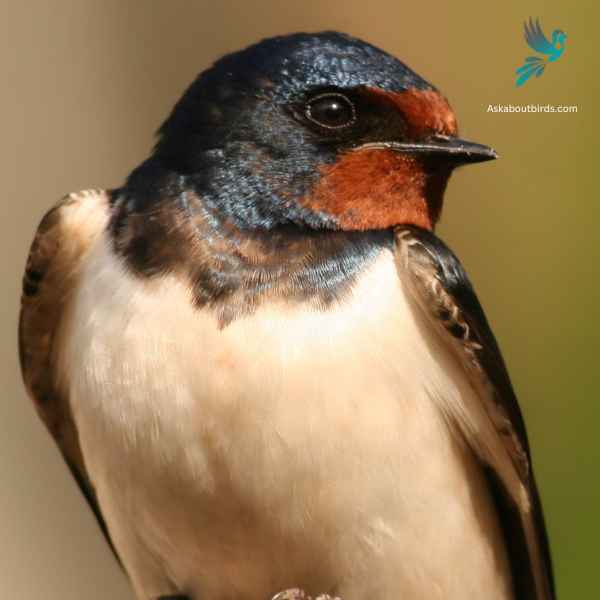
| Feature | Measurement |
|---|---|
| Scientific Name | Hirundo rustica |
| Length | 6.5–7.5 in |
| Wingspan | 12.5–13.5 in |
| Weight | 16–22 g |
The Barn Swallow is a sleek, agile bird renowned for its graceful flight patterns and iconic forked tail, often seen darting over fields and water bodies in search of flying insects.
Appearance: Barn Swallows have deep blue, almost iridescent, upperparts and a rufous to tawny underbelly. Their distinctively forked tail and long wings give them a streamlined look. Both males and females have a similar appearance, though males often exhibit slightly brighter colors and a deeper fork in the tail.
Diet: Barn Swallows feed primarily on flying insects, which they catch in mid-air during their agile and acrobatic flights. Their diet includes flies, beetles, moths, and other small flying insects.
Reproduction: Barn Swallows are known for building their mud nests on man-made structures, particularly barns, bridges, and eaves. The nest is cup-shaped and made from mud pellets, often lined with feathers. The female lays a clutch of 4 to 6 eggs.
American Robins


| Feature | Measurement |
|---|---|
| Scientific Name | Leptotila plumbeicep |
| Length | 10.6-11.8 in |
| Wingspan | — |
| Weight | 160-200 g |
The American Robin is a widely recognized bird species known for its melodious song and early bird tendencies.
Appearance: American Robins are medium-sized birds with a distinctive appearance. Both males and females sport a gray to brown back and a warm red to orange breast and belly and gray wings. They also have a characteristic white eye-ring and a black head, but males are usually darker than females.
Diet: American Robins have a diverse diet that changes depending on the season. In summer, they feed heavily on earthworms, beetles, and other invertebrates, which they catch on the ground. During winter, they mostly eat fruits and berries.
Reproduction: American Robins usually build their nests in trees or shrubs, but they are also known to nest on human-made structures. The female lays a clutch of about 3 to 5 eggs, which she incubates for about 12 to 14 days.
Red Crossbill
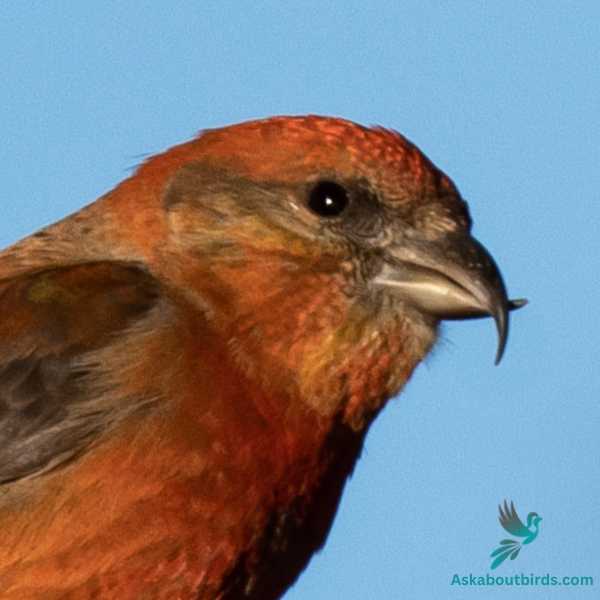

| Feature | Measurement |
|---|---|
| Scientific Name | Loxia curvirostra |
| Length | 20 cm |
| Wingspan | 27–29 cm |
| Weight | 40-53 g |
The Red Crossbill is a peculiar bird species, celebrated for its unique beak structure and vibrant coloration.
Appearance: Red Crossbills are named for their distinctive crossed mandibles, which are adapted to extracting seeds from conifer cones. Male Red Crossbills are usually bright red or orange, while females and juveniles are greenish-yellow. All have dark wings and notched tails.
Diet: The diet of the Red Crossbill is primarily composed of conifer seeds, their unique beak allowing them to access these seeds with ease. This diet includes seeds from pine, spruce, and other types of coniferous trees. They are also known to consume some insects.
Reproduction: Red Crossbills are known for their flexible breeding season, which can occur any time of the year when there is an abundance of food. They typically nest in conifers, where the female lays a clutch of 3 to 4 eggs.
American Redstart


| Feature | Measurement |
|---|---|
| Scientific Name | Setophaga ruticilla |
| Length | 4.3 to 5.5 in |
| Wingspan | 6.3 to 9.1 in |
| Weight | 8.6 g |
The American Redstart is a lively warbler known for its vivid colors and active hunting style, often seen flitting about, fanning its tail to startle and catch insects.
Appearance: Adult male American Redstarts boast striking black plumage with bright orange patches on the sides, wings, and tail. Females and immature males have grayish-olive upperparts with yellow patches in the same areas where the males display orange.
Diet: American Redstarts are primarily insectivores. They actively forage for flying insects, as well as caterpillars and spiders, often using their colorful tails to startle prey and make them easier to catch.
Reproduction: The female American Redstart builds a cup-shaped nest in the fork of a tree branch. Typically, she lays a clutch of 3 to 5 eggs. The female takes on the primary responsibility of incubating the eggs, while both parents participate in feeding the fledglings after they hatch.
Blackburnian Warbler
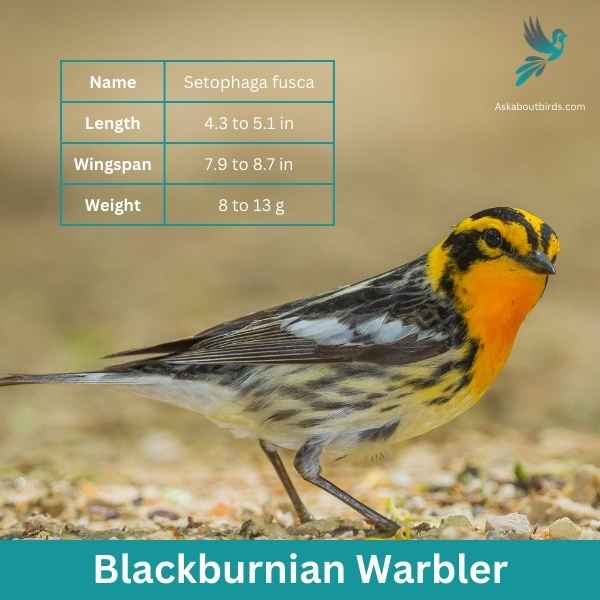

| Feature | Measurement |
|---|---|
| Scientific Name | Setophaga fusca |
| Length | 4.3 to 5.1 in |
| Wingspan | 7.9 to 8.7 in |
| Weight | 8 to 13 g |
The Blackburnian Warbler is a strikingly colored songbird that captivates observers with its vivid plumage, especially during the breeding season. Often found flitting high in the treetops of North American forests, its melodious song is as enchanting as its appearance.
Appearance: Male Blackburnian Warblers are distinguished by their fiery-orange throats, contrasting sharply with a black face, crown, and streaked back. They also have white underparts with black streaks on the sides. Females have a more muted coloration, with a yellowish or pale orange throat and less pronounced streaking.
Diet: Blackburnian Warblers primarily feed on insects and spiders. They are adept at foraging in the canopy, where they glean insects from the surface of leaves and branches or catch them mid-air in quick, agile flights.
Reproduction: Blackburnian Warblers build their nests high up in coniferous trees, often on horizontal branches. The nest is a neat cup made of twigs, grass, and moss, lined with softer materials like hair or feathers. The female lays a clutch of 4 to 5 eggs and takes the lead in incubation.
Where to Spot North Dakota’s Orange Birds
North Dakota, a haven for birdwatchers, offers landscapes that are both rugged and serene, drawing in a kaleidoscope of avian species. Delving deep into its terrains, here are some prime spots that are simply irreplaceable for spotting a variety of orange birds:
- Chase Lake National Wildlife Refuge: Home to one of the largest pelican colonies, this refuge is a mosaic of wetlands and prairies, inviting diverse bird species, including many with hints of orange plumage.
- Lostwood National Wildlife Refuge: Spread across the northwestern region, this refuge provides an excellent habitat for grassland birds, making it a hotspot for those seeking to observe the beauty of orange-feathered species amidst pristine nature.
- Theodore Roosevelt National Park: Beyond its bison and wild horses, this park’s sweeping badlands are a magnet for numerous bird species. The mix of terrains offers varied habitats that attract a rich diversity of avian life.
- Pipestem Creek Garden Lodging and Nature Retreat: A renowned birding locale, it’s especially vibrant in spring and fall migration. The varied habitats of woods, water, and grasslands attract a spectrum of birds, with orange-tinted ones being a real treat for watchers.
- Devils Lake: Not just a hotspot for fishing, the diverse aquatic environment and surrounding woodlands are frequented by numerous bird species, making it a favored location for bird enthusiasts keen on spotting colorful birds against the backdrop of serene waters.
| State’s Orange Birds | Best Spots for Orange Birds |
|---|---|
| South Dakota’s Orange Birds | 1. Custer State Park 2. Badlands National Park 3. Sica Hollow State Park |
| Montana’s Orange Birds | 1. Glacier National Park 2. Lee Metcalf National Wildlife Refuge 3. Bitterroot Valley |
| Minnesota’s Orange Birds | 1. Superior National Forest 2. Sax-Zim Bog 3. Tamarac National Wildlife Refuge |
FAQs on Orange Bird Species Found in North Dakota
What is the bright orange bird in South Dakota?
In South Dakota (indeed throughout North dakota as well) , the Baltimore Oriole is a standout with its brilliant orange and black coloration. Particularly during the warmer months, male Baltimore Orioles showcase their bright orange plumage and bellies contrasted with a black head, back, and wings.
What birds are light orange?
Birds with a light orange hue include the Orchard Oriole, which has a more muted or russet-orange color compared to the bright orange of the Baltimore Oriole. Female Scarlet Tanagers also display a light orange or yellowish-orange plumage.
What bird is gray with orange underbelly?
The Say’s Phoebe, a type of flycatcher, is characterized by its gray upperparts and a contrasting orange or rusty-orange underbelly. They can be found in the western parts of North America and may be spotted in open areas, perching conspicuously as they watch for insects to catch in flight.
In the diverse avian world, there are several birds that captivate watchers with their unique features and colors. Birds with a bright yellow breast, like the Yellow Warbler, often stand out in a verdant backdrop, drawing the eyes of even the most casual observer. On the other hand, the Dark-eyed Junco is easily recognized by its distinctive white outer tail feathers, especially noticeable when the bird takes flight. These specific traits, however, don’t overshadow the beauty of other birds like those sporting dark blue plumage. The Indigo Bunting, for instance, is a dazzling representative of such blue-feathered wonders, offering a stunning contrast to the more commonly found hues in nature.





